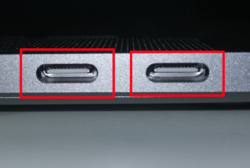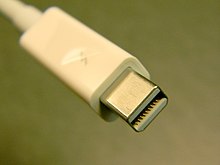Thunderbolt (interface)
Thunderbolt ( English for thunderbolt or lightning ) is the name of an interface developedby Intel in collaboration with Apple initially under the code name Light Peak - a protocol between computers , monitors , peripheral devices and entertainment electronics such as video cameras or hard drives . Technically, it is a combination of DisplayPort and a PCI Express- based interface.
On March 4, 2019, the standardization organization USB-IF announced that USB4 would be developed on the basis of Thunderbolt 3.
This was preceded by the transfer of the licenses from the inventor Intel to USB-IF, so that all manufacturers can use Thunderbolt license-free in the future.
development
| interface | Clock rate (MHz) |
Line code |
Data rate (GBit / s) | source | |
|---|---|---|---|---|---|
| 1 lane | 2 lanes | ||||
| Thunderbolt 1 | 10 312.5 | 64b66b | 10 | - | |
| Thunderbolt 2 | 10 312.5 | 64b66b | 10 | 20th | |
| Thunderbolt 3 | 20 625 | 64b66b | 20th | 40 | |
The Thunderbolt interface was first presented internally at the IDF 2009 in- house exhibition and officially presented on February 24, 2011. For cost reasons, optical transmission was initially dispensed with; instead, electrical transmission via copper cables is used. However, since Thunderbolt uses active cables - that is, there is electronics in the cable plugs that hide the physical layer of the transmission path (the transmission medium) from the device - all devices would also be compatible with optical cables if these were to be introduced. Mechanically and electrically, Thunderbolt is backwards compatible with the DisplayPort with mini DisplayPort connectors.
The first devices to be equipped with this technology are Apple's MacBook Pro series , which have been available since February 24, 2011. According to Intel's plans, Thunderbolt should establish itself as a universal connection and offer enough capacity for the transfer of large amounts of data in the near future. Thunderbolt is based on several parallel bidirectional channels on which data is transmitted serially. Existing protocols such as DisplayPort and PCI Express are used. Initially (that is, not with Thunderbolt 2) there are two bidirectional channels with transfer rates of 10 GBit / s, but the technology offers the potential for much higher data rates ; In 2009, Intel set the goal of achieving 100 GBit / s within ten years. In addition, the technology can support different protocols at the same time, making it more flexible to use. Electrical cables are specified by Intel to be up to three meters, optical cables, if they existed, would allow longer cable lengths of over 10 meters.
Thunderbolt docking stations are intended to replace USB docking stations and no longer have the previous usage restrictions of a generic port replicator .
Thunderbolt has also been available on Windows systems since 2012. The Thunderbolt interface is an alternative to the ( gross ) about half as fast USB 3.0 bus . However, USB has the advantages of being compatible with the widespread older USB interfaces and of offering an optional higher operating voltage or performance. In addition, USB costs significantly less in the aftermarket.
Thunderbolt 2
In June 2013, Intel introduced the next Thunderbolt generation called Thunderbolt 2 , based on the controller called Falcon Ridge . Production started at the end of 2013. It offers a data rate of 20 GBit / s, which is made possible by merging the two data and display channels that are already 10 GBit / s without changing the speed. The available bandwidth can thus be used more flexibly. Thunderbolt 2 was first announced by Apple in June 2013 at WWDC for the new Mac Pro .
Thunderbolt 3
In mid-2015, the Thunderbolt consortium presented the third version, which connects the rotatable USB-C connector with the maximum version of the USB 3.1 specification as a physical feature and increases the transfer rate to up to 40 Gbit / s. The interface is intended to bundle all image, sound, energy and data transmission channels in one interface and, thanks to the active interfaces with optical transmission, also allows large ranges.
Thunderbolt 4
In January 2020, Intel will announce Thunderbolt 4 at the US Consumer Electronics Show (CES). This news came as a surprise to the market because Intel had passed the Thunderbolt standard to the USB Implementers Forum (USB-IF) standardization organization on March 4, 2019 , which publishes USB standards and uses Thunderbolt as the technical basis for the USB4 version . However, in the USB4 standard, many components are optional and the customer cannot clearly see which variant was used. In contrast, all optional components are mandatory under the Thunderbolt 4 standard.
Thunderbolt 4 has taken over the connector and the transfer rate of 40 GBit / s from Thunderbolt 3 and integrates the 20 GBit / s level of USB 3.2 which is not provided in Thunderbolt 3. The first devices should come onto the market at the end of 2020.
compatibility
Apple offers an adapter to connect devices with a Thunderbolt 2 port to devices with a Thunderbolt 3 / USB-C socket.
functionality
Thunderbolt is integrated into devices as a controller. The first version was based on copper lines, later versions added a module for converting optical and electrical signals. Series connections of up to six peripheral devices without loss of performance are also possible. Interconnected Thunderbolt chips work with a synchronous clock signal. In order to avoid runtime problems, the timers should only differ from each other by up to eight nanoseconds for a maximum of seven hops in a Thunderbolt device chain.
A Thunderbolt cable is technically very complex. Twelve chips are built into the two plugs of a cable (as of 2012). This explains the elongated and bulky design of the connector and the heating during operation.
Security problem
If you plug in a device, you have the option of direct memory access - reading and writing. This gateway is to be limited by IOMMU on the host side, but only supports Windows 10 Enterprise IOMMU under Windows. It is usually not active anyway. Under Linux IOMMU is supported in the kernel, but inactive in all common distributions.
Specifications
Thunderbolt 3
- Thunderbolt
- 40 Gbit / s Thunderbolt 3 - twice the speed compared to Thunderbolt 2
- 4 PCI-Express 3.0 lanes (= 32 Gbit / s), e.g. for external graphics card (eGPU)
- Thunderbolt network - 10 Gbps Ethernet between computers
- USB - Compatible with existing USB devices and cables
- USB 3.1 Gen 2 (10 Gbit / s)
- USB-C connector and cable (small, rotationally symmetrical)
- DisplayPort - Compatible with existing DisplayPort devices and cables
- Power supply (based on USB Power Delivery )
- up to a power of 100 watts
- 15 watts for devices powered by the bus
- Looping through of up to six devices
- lowest latency for PCI-Express audio recording
Retrofitting
At Computex in Taipei in 2012, Asus presented the first plug-in card with which PC mainboards can be expanded to include Thunderbolt functionality that would otherwise not support Thunderbolt. This card, called ThunderboltEX , only works with Asus and Gigabyte boards that the manufacturers declare to be suitable for this.
For full functionality, the card must be connected with a DisplayPort cable, the other end of which is plugged into the DP output of the onboard graphics or graphics card (loop-through cable). One advantage is that an existing graphics card can also be used together with Thunderbolt. So you don't have to rely on Intel's HD Graphics to control a monitor using Thunderbolt. The ThunderboltEX also works if no DP cable is supplying the display signals. Then, although data transfer to other TB devices is possible, a Thunderbolt monitor cannot be supplied with images.
In the meantime, further developments of this retrofit solution have appeared under the names Asus ThunderboltEX 2 and Asus ThunderboltEX 3 . The principle with the loop-through cable was retained. The cards can only run on mainboards with the appropriate BIOS support. When designing the ThunderboltEX 3 card , Asus already switched the Thunderbolt connector to USB-C , the ThunderboltEX 2 card still has the TB socket shown above. In addition, there is the USB-C function of delivering electrical power to external devices, in this case of up to 36 watts, so that they can be operated without their own power supply unit.
Web links
- intel.de/… - Intel Thunderbolt technology
- thunderbolttechnology.net - official website for Intel developers
- apple.com/… - Apple's official website for the Thunderbolt interface
- patentlyapple.com/… - Apple patents on Thunderbolt
- What is Thunderbolt? - Thunderbolt at a glance at www.allround-pc.com
Individual evidence
- ^ Brian Klug: Intel's code name Light Peak Launches as Thunderbolt , AnandTech, 2011-02-25
- ↑ Processor: Intel will integrate Thunderbolt 3 into CPUs - Golem , May 26, 2017
- ↑ THUNDERBOLT TECHNOLOGY: The Fastest Connection To Your PC Experience (English) - (formerly at) Intel (now in the Internet archive ; last saved on September 23, 2011)
- ↑ https://usb.org/sites/default/files/2019-03/USB_PG_USB4_DevUpdate_Announcement_FINAL_20190226.pdf USB Promoter Group Announces USB4 Specification
- ↑ Florian Müssig: Thunderbolt 3 becomes USB 4. In: Heise online . 4th March 2019 . Retrieved March 5, 2019.
- ↑ elektronikjk.pl
- ↑ datatec.de
- ↑ a b c Intel Corporation: Intel shows future solutions for mobile devices of all sizes and starts new software developer program - fast data transfer with "Light Peak" technology , (archived on August 18, 2011)
- ↑ www.engadget.com , Intel unveils Light Peak 10 Gbps optical interconnect for mobile devices (English)
- ↑ Copper instead of fiber optics: Intel's Light Peak sees no light - Golem , December 10, 2010
- ↑ Apple Updates MacBook Pro with Next Generation Processors, Graphics & Thunderbolt I / O Technology ( Memento from June 29, 2011 in the Internet Archive )
- ↑ a b Apple - Thunderbolt: next-generation high-speed I / O technology.
- ↑ a b intel.com - THUNDERBOLT TECHNOLOGY: The Fastest Connection To Your PC Experience
- ↑ PC Games Hardware - Intel officially introduces Thunderbolt alias Light Peak with 10 Gbps
- ↑ Christof Windeck: IDF: Thunderbolt from 2012 also in Windows computers. In: Heise online . September 15, 2011 . Retrieved June 16, 2017.
- ↑ Thunderclap: Macs and PCs vulnerable to malicious Thunderbolt peripherals , heise.de, on March 1, 2019.
- ↑ Lucas Mearian: Thunderbolt vs. SuperSpeed USB 3.0. In: Computerworld . October 10, 2011, accessed January 26, 2013 .
- ↑ Video Creation Bolts Ahead - Intel's Thunderbolt 2 Doubles Bandwidth, Enabling 4K Video Transfer & Display. Intel, June 4, 2013, accessed October 21, 2013 .
- ↑ Johannes Schuster: WWDC: New Mac Pro with Thunderbolt 2.0 and USB 3.0. In: Heise online . June 10, 2013 . Retrieved October 21, 2013.
- ↑ Thunderbolt 3 - The USB-C That Does It All. Intel Cooperation, June 2, 2015, accessed October 18, 2015 .
- ↑ a b c d Florian Müssig: Thunderbolt 4 is USB 4 in full expansion. In: heise online. January 10, 2020, accessed January 11, 2020 .
- ↑ Apple A1790
- ↑ Disassembly with descriptive photos
- ↑ Hanno Böck: Thunderbolt connections allow attacks on RAM
- ↑ ThunderboltEX 3. Asus, accessed November 1, 2016 .


